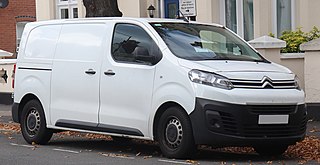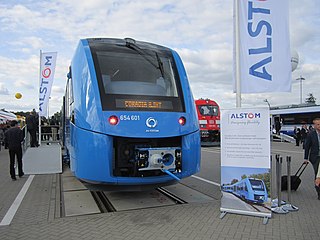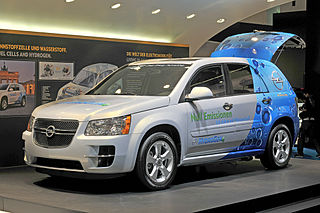
A fuel cell is an electrochemical cell that converts the chemical energy of a fuel and an oxidizing agent into electricity through a pair of redox reactions. Fuel cells are different from most batteries in requiring a continuous source of fuel and oxygen to sustain the chemical reaction, whereas in a battery the chemical energy usually comes from substances that are already present in the battery. Fuel cells can produce electricity continuously for as long as fuel and oxygen are supplied.

A hydrogen vehicle is a vehicle that uses hydrogen fuel for motive power. Hydrogen vehicles include hydrogen-fueled space rockets, as well as ships and aircraft. Motive power is generated by converting the chemical energy of hydrogen to mechanical energy, either by reacting hydrogen with oxygen in a fuel cell to power electric motors or, less commonly, by burning hydrogen in an internal combustion engine.

The Fiat Panda is a city car manufactured and marketed by Fiat since 1980, currently in its third generation. The first generation Panda, introduced in 1980, was a two-box, three-door hatchback designed by Giorgetto Giugiaro and Aldo Mantovani of Italdesign and was manufactured through 2003 — receiving an all-wheel drive variant in 1983. SEAT of Spain marketed a variation of the first generation Panda under license to Fiat, initially as the Panda and subsequently as the Marbella (1986–1998).

A fuel cell vehicle (FCV) or fuel cell electric vehicle (FCEV) is an electric vehicle that uses a fuel cell, sometimes in combination with a small battery or supercapacitor, to power its onboard electric motor. Fuel cells in vehicles generate electricity generally using oxygen from the air and compressed hydrogen. Most fuel cell vehicles are classified as zero-emissions vehicles that emit only water and heat. As compared with internal combustion vehicles, hydrogen vehicles centralize pollutants at the site of the hydrogen production, where hydrogen is typically derived from reformed natural gas. Transporting and storing hydrogen may also create pollutants. Fuel cells have been used in various kinds of vehicles including forklifts, especially in indoor applications where their clean emissions are important to air quality, and in space applications. Fuel cells are being developed and tested in trucks, buses, boats, ships, motorcycles and bicycles, among other kinds of vehicles.

The Fiat Seicento is a city car produced by the Italian company Fiat, introduced at the end of 1997 as a replacement for the Fiat Cinquecento, although it was also based on the Cinquecento. The Seicento did not differ much from its predecessor, retaining the same engines, chassis and general dimensions, although it did gain a minor 90 mm in length.

The Citroën Jumpy is a light commercial van jointly developed by Fiat Group and PSA Group, and mainly manufactured by Sevel, a joint venture between the two companies since 1994. The Jumpy was also sold as the Peugeot Expert and Fiat Scudo beginning in 1995.

The Honda Clarity is a nameplate used by Honda on alternative fuel vehicles. It was initially used only on hydrogen fuel-cell electric vehicles such as the 2008 Honda FCX Clarity, but in 2017 the nameplate was expanded to include the battery-electric Honda Clarity Electric and the plug-in hybrid electric Honda Clarity Plug-in Hybrid, in addition to the next generation Honda Clarity Fuel Cell. Clarity production ended in August 2021 with US leases for the fuel cell variant continuing through to 2022.
Hydrogen technologies are technologies that relate to the production and use of hydrogen as a part hydrogen economy. Hydrogen technologies are applicable for many uses.

The Toyota FCHV is a hybrid hydrogen fuel cell vehicle development programme of the Toyota Motor Corporation, which was leased to a limited number of drivers in the United States and Japan beginning in 2002. The Toyota FCHV and Honda FCX, which began leasing on 2 December 2002, became the world's first government-certified commercial hydrogen fuel cell vehicles. Its first commercial fuel cell vehicle was developed from the FCHV-4, which was adapted from the Toyota Highlander body. "FCHV" stands for "Fuel Cell Hybrid Vehicle". A number of prototypes have been produced, up to the latest FCHV-adv ("advanced").

HydroGen3 was an Opel hydrogen fuel cell concept vehicle used for testing in 2006. HydroGen3's 400-kilometer (250 mi) driving range is the highest of any fuel cell vehicle approved for public roads in Japan. The five seater front-wheel driven prototype is based on the Opel Zafira compact MPV.
The Honda FCX is a family of hydrogen fuel cell automobiles manufactured by Honda.

In transportation, hydrogen fuel cell train or hydrail is the generic term describing all forms of rail vehicles, large or small, which use on-board hydrogen fuel as a source of energy to power the traction motors, or the auxiliaries, or both. Hydrail vehicles use the chemical energy of hydrogen for propulsion, either by burning hydrogen in a hydrogen internal combustion engine, or by reacting hydrogen with oxygen in a fuel cell to run electric motors. Widespread use of hydrogen for fueling rail transportation is a basic element of the proposed hydrogen economy. The term has been used by research scholars and technicians around the world.

HydroGen4 is the successor of the fuel cell vehicle HydroGen3, developed by General Motors/Opel and presented in 2007 at the IAA in Frankfurt, Germany. It is expected that automotive hydrogen technology, such as the type featured in the HydroGen4, may enter the early commercialization phase in the 2015–2020 time frame.
The Fiat Phyllis is a prototype fuel cell-type hydrogen vehicle introduced in the International Motor Show Bologna (Italy) held til 14 December 2008. Car's engineers are the Ecole Polytechnic of Turin and the Fiat Research Center who concocted.

The Fiat Phylla concept car was unveiled in 2008 by the Italian car manufacture Fiat. Originally expected to form the basis of a production car in 2010, it remains a concept city car. The Phylla name means "leaves" in ancient Greek.

The Fiat Mini platform is an automobile platform shared among city cars of the Fiat Group.

The Toyota Mirai is a mid-size hydrogen fuel cell vehicle (FCV) manufactured by Toyota, and is the first FCV to be mass-produced and sold commercially. The Mirai was unveiled at the November 2014 Los Angeles Auto Show. As of November 2022, global sales totaled 21,475 units; the top-selling markets were the U.S. with 11,368 units, Japan with 7,435 and the rest of the world with 2,622.

The Hyundai ix35 FCEV or Tucson FCEV is a hydrogen fuel cell electric vehicle developed by Hyundai. The model is a left-hand drive only conversion to the SUV platform it is based on and was the first of its type to be mass-produced and sold commercially in the world. Different versions are known, the previous version was based on the Hyundai Tucson FCEV, and the upcoming model is based on the current ix35 FCEV. The first generation was introduced in 2001, with the Hyundai Santa Fe FCEV, and had a range of 100 miles (160 km), with a top speed of 78 mph (126 km/h).

Designed by Dante Giacosa, the Fiat 100 engine first appeared in a 633 cc (38.6 cu in) form in the all-new Fiat 600 in 1955. The in-line four-cylinder engine comprised an iron block and an aluminium cylinder head with pushrod actuated valves. The engine was produced at Fiat's Mirafiori (Turin) plant, and then at Bielsko-Biała, and remained in production until 2000, used in Fiat Panda and Fiat Seicento in its last 899 cc (54.9 cu in) capacity version fitted with SPI single-point injection and hydraulic tappets, although slowly being phased out starting from 1985 in favour of the new Fiat FIRE engine. It was also produced until 2008 in the Zastava plants in Kragujevac.



















